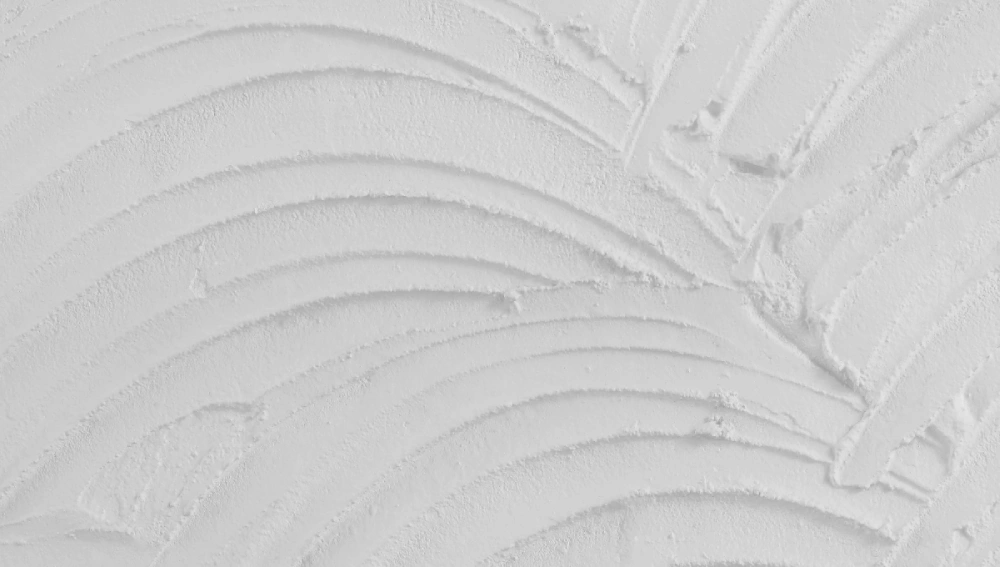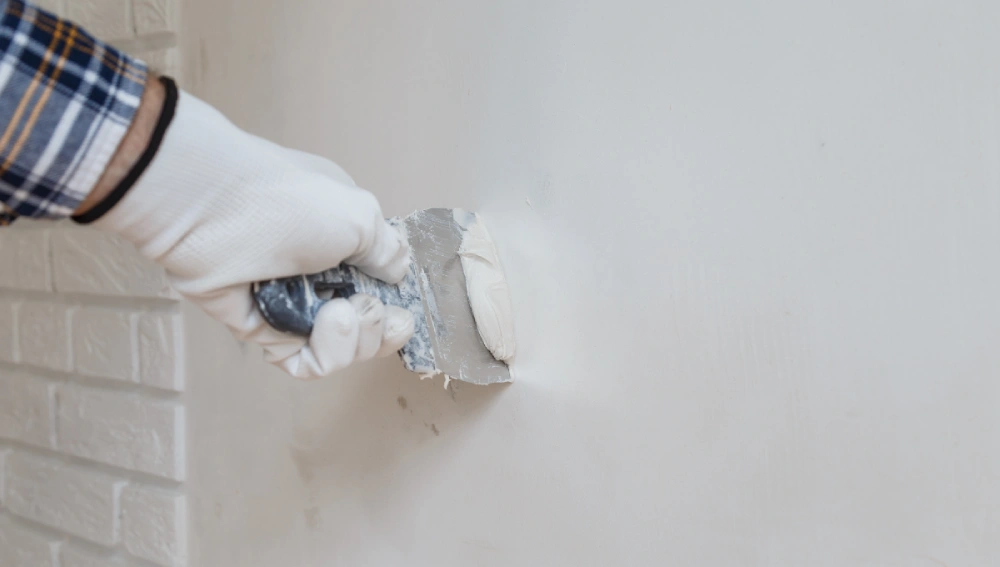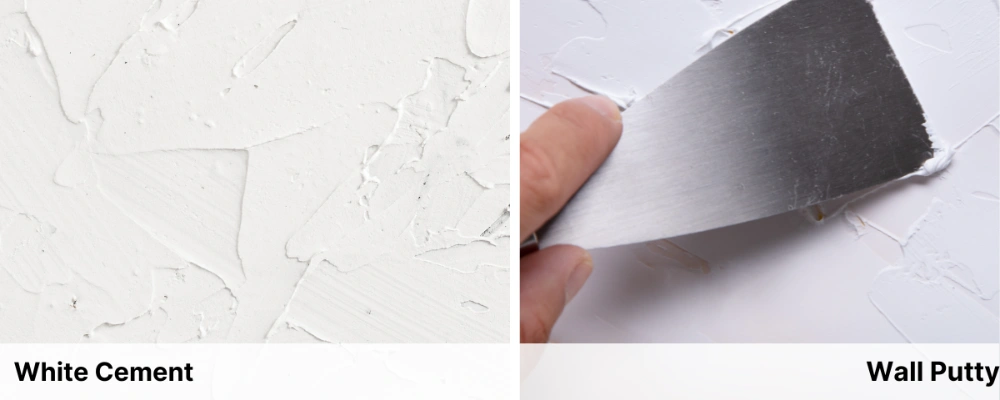White cement and wall putty are two materials builders and DIY enthusiasts often use. They have different purposes and unique traits. Knowing how they differ can help you pick the right one for what you need to do.
What is White Cement?

It is simple to recognize the special variety of Portland cement known as “white cement” due to its pure white hue. This is made using low concentrations of manganese oxide (MnO2) and ferric oxide (Fe2O3). Its manufacturing involves the use of gypsum, clay, and limestone.
Properties of White Cement
- Color: The white shade makes it perfect for uses where looks matter.
- Strength: White cement is as strong as regular Portland cement, so it’s tough and dependable for many building projects.
- Setting Time: It takes a reasonable time to set, which gives you some leeway when you’re using it.
- Resistance: It stands up well to adverse weather and sunlight so you can use it outside without worry.
Uses of White Cement
- Architectural Finishes: White cement plays a role in decorative finishes, terrazzo flooring, and ornamental concrete products because of its attractive color.
- Tile Grouting: People use it to grout tiles to match or complement the tile color.
- Precast Products: The production of precast architectural panels, balustrades, and sculptures often involves white cement.
- Surface Coatings: It is used in reflective paints and coatings for roads and pavements.
What is Wall Putty?

Wall putty is a fine white powder. Manufacturers create it by mixing white cement, polymers, and fillers. It is used to get walls and ceilings ready for painting after plastering, where it helps to create a smooth even surface. Properties of Wall Putty
- Smoothness: Wall putty makes walls smooth, getting rid of any flaws on the surface.
- Adhesion: It sticks well, which helps the paint stick better to the wall.
- Water Resistance: Wall putty offers some protection against water by keeping the paint safe from dampness.
- Flexibility: It bends a little, which helps stop cracks from forming on the painted surface.
Uses of Wall Putty
- Surface Preparation: Wall putty is used mainly to get walls ready for painting and fill cracks, holes, and flaws.
- Paint Base: It gives a good base for paint, which makes the paint look better and last longer.
- Smooth Finish: People use wall putty to make interior and exterior walls smooth. This makes the paint job look better overall.
One significant advantage of wall putty is that it provides a white base. This white layer ensures that any chosen paint color is clearly visible and vibrant on the wall, preventing discoloration caused by underlying structural materials. This makes the final paint color more accurate and true to its intended shade.
Key Differences Between White Cement and Wall Putty
Composition
- White Cement: Limestone, clay, and gypsum make up white cement. It has little iron and manganese to keep its color.
- Wall Putty: White cement, polymers, and fillers form wall putty. These parts work together to make it smooth and sticky.
Purpose
- White Cement: It is used to build and decorate and . gives strength and looks good.
- Wall Putty: It is used to get walls ready for painting and . makes surfaces smooth and sticky.
Application
- White Cement: Builders apply it to make things look nice, fill gaps in tiles, and make precast products.
- Wall Putty: Painters apply it on walls and ceilings to make them smooth before painting.
Strength and Durability
- White Cement: It’s strong enough to hold up buildings and can bear heavy loads.
- Wall Putty: It doesn’t make building components stronger.
Color and Finish
- White Cement:This type of cement is finely ground and has a smooth texture. It’s used in construction where color and finish are crucial. White cement provides a clean and bright surface, but it is generally coarser compared to wall putty.
- Wall Putty: This material is also white but has a much finer, smoother texture. It’s specifically designed to fill in minor surface imperfections and create an even base for painting. However, it is generally not visible after painting.
Setting or Drying Time
- White Cement: White cement typically sets in about 30 to 60 minutes, depending on the specific product and weather conditions. This moderate setting time makes it suitable for various applications.
- Wall Putty: Wall putty dries usually within 3-6hours, allowing you to paint over. Advantages and Disadvantages
Advantages of White Cement
- Looks Good: Its white color makes it a good fit for decoration and building design.
- Lasts Long: Has great strength and stands up to adverse weather, which is perfect for outdoor usage
- Useful in Many Ways: People can use it in numerous ways, from ready-made products to coatings on surfaces.
Drawbacks of White Cement
- Price: White cement costs more than regular Portland cement because it needs extra work to get its color.
- Not Always Needed: Its main plus is its color, which you might not need for every job.
Advantages of Wall Putty
- Smooth Finish: Makes surfaces smooth and enhances the paint finish.
- Better Sticking: Helps paint stick to walls better and cuts down on paint peeling or flaking risks.
- Fights Water Seepage: Gives some shield against dampness, which can make the paint last longer.
Drawbacks of Wall Putty
- No Added Strength: Wall putty doesn’t make walls or ceilings stronger.
- Susceptible to Damage: Wall putty can be prone to chipping or cracking over time, especially in high-traffic areas or in extreme temperature conditions.
Picking Between White Cement and Wall Putty
Your choice between white cement and wall putty hinges on the following factors :
- What Your Project Needs: Figure out if you need something strong or just something to smooth out surfaces.
- How Much You Can Spend: Think about how much the material and the labour will cost for each choice.
- How You Want It to Look: Decide if how the material looks matters for what you’re doing.
Conclusion
White cement and wall putty are different materials. They have different ingredients, uses, and features. White cement works best when you need something strong and good-looking. When it comes to preparing surfaces for painting, wall putty is the best option. Knowing the differences and the uses of these two coatings will help you pick out the most appropriate one. Generally, applying wall putty is a necessity in the construction process, while the use of white cement is only optional and purely for aesthetic purposes.
FAQs
White cement has some uses similar to wall putty, like smooth surfaces, but it doesn’t stick as well or make surfaces as smooth. Wall putty is made just to get surfaces ready for paint and works better for this job.
Wall putty isn’t waterproof, but it keeps out some water, which helps shield the paint from moisture and damp air. To get even more protection, it’s smart to use good-quality paint and sealer over the putty.
Wall putty takes about 3 to 6 hours to dry. This depends on the thickness of each coat, weather conditions and room temperature. Hence, the best thing is to wait for at least 24 hours before painting over wall putty in order to ensure it has set completely.

